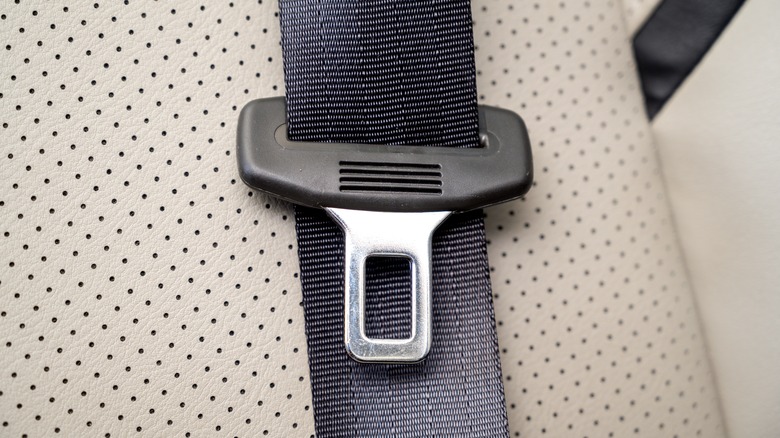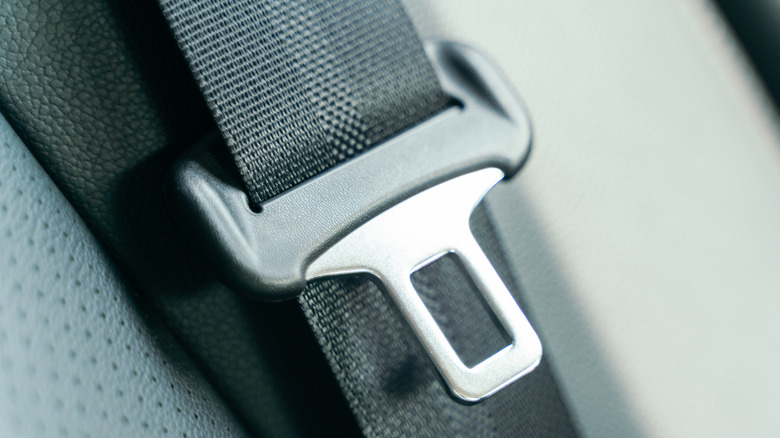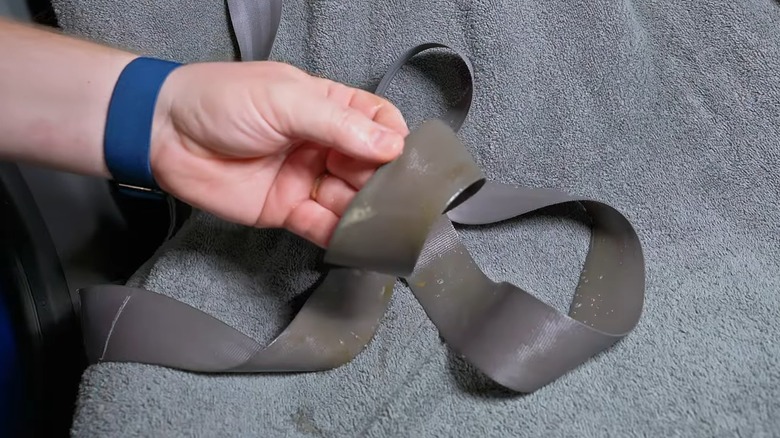How To Clean Your Car's Seat Belts (And Get Rid Of Stains)
We may receive a commission on purchases made from links.
Keeping your vehicle in the best shape possible is quite an involved process. Not only is there routine maintenance you need to keep track of and dashboard warning lights to heed, but cleaning is also a factor to consider. Giving the exterior a good wipe down and rinse can remove dirt and debris to give your ride a nice shine, and scrubbing and vacuuming the interior can revitalize seats and carpets alike. If you really want to be thorough, you can clean up oft-forgotten things like grimy car cupholders as well as your car's potentially filthy seat belts.
Seat belts are an essential element in the modern vehicle and, surprisingly, use tiny explosives to save lives in the event of an accident. Every time you enter an automobile, whether as the driver or one of the passengers, it's crucial to buckle up before hitting the road. Therefore, considering how frequently used and touched seat belts are, it's no surprise that these safety mechanisms can get quite dirty over time.
Food and drink spills, exposure to the elements, and even the oils in one's skin can get them pretty unsightly after a while. Thankfully, there's not much difficulty in cleaning seat belts up, and it only takes a few simple steps and common products to do so.
How to clean a dirty seatbelt
Before cleaning up your seat belts, there are a few key items to get together first. You'll want a clamp that can hold the seat belt in place, a stiff brush to scrub, and your cleaner of choice. Warm water and soap and pre-made seat belt cleaner are ideal in most cases, though the combination of dish soap, vinegar, and warm water – typically a gallon of water, half a cup of vinegar, and a few drops of dish soap will do the trick — and or a mixture of warm water and baking soda is recommended for seat belts exuding a bad smell.
- Pull the seat belt you want to clean all the way out and use a clamp to keep it from retracting.
- Apply your chosen cleaner to the seat belt and scrub using the brush. Do so back and forth in a straight line and in the same direction as its fibers. Apply some pressure as you brush, but don't overdo it, or you risk damaging the seat belt itself.
- Once you're done scrubbing, take a dry towel and run it up and down the seat belt until you dry it off as much as you can. Leave the clamp on so that the seat belt can completely dry overnight. If it's retracted while still damp, this could quickly lead to the formation of mold.
You can purchase affordable clamps like this pack of 12 for $10 on Amazon. Alternatively, if you have a steam cleaner, like the Bissell Little Green portable cleaner, you can use that to clean your seat belts, too. With the cleaner applied, simply blast away in an up-and-down, straight-line motion until the solution is gone. Dry with a towel and leave to air dry as you would with the brush technique.
What to use for stubborn seat belt stains
Though soapy water and steam cleaners from Harbor Freight or other sources can go a long way in getting your seatbelts in like-new condition, sometimes even they meet their limits. Like with anything made of cloth material, sometimes seatbelts get stained and require additional support to get these more stubborn stains out. The first thing to try is a more potent cleaner-water mixture, like three parts all-purpose cleaner to one-part warm water, which, with some diligent scrubbing, could get the job done. If it doesn't, you'll have to resort to other means to get the job done.
The majority of seat belts one will come across in modern cars are made from polyester, with nylon being the standard for most older rides. With this in mind, you can try some homemade polyester cleaning methods. A popular choice is the baking soda method, which involves sprinkling it on a dampened stain, leaving it overnight, wiping it off, and cleaning the seat belt as normal. To ensure your scrubbing is thorough, there are special brushes you can buy that are specifically designed to clean seat belts. Alternatively, equal parts baking soda and hot water can be mixed to form a paste. Leave it on the stain for around 10 minutes, wipe it off, and repeat if needed.
As a frequently touched and very much exposed part of a vehicle's interior, your seat belts are all but guaranteed to get dirty. So long as you have the proper cleaner and other equipment, though, there likely isn't a stain or smudge you can't get out with a little time and effort.


